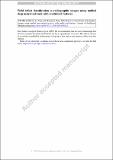Weld defect classification in radiographic images using unified deep neural network with multi-level features
Author(s)
Yang, Lu; Jiang, Hongquan
Download10845_2020_1581_ReferencePDF.pdf (1.742Mb)
Publisher Policy
Publisher Policy
Article is made available in accordance with the publisher's policy and may be subject to US copyright law. Please refer to the publisher's site for terms of use.
Terms of use
Metadata
Show full item recordAbstract
Deep neural network (DNN) exhibits state-of-the-art performance in many fields including weld defect classification. However, there is still a large room for improving the classification performance over the generic DNN models. In this paper, a unified deep neural network with multi-level features is proposed for weld defect classification. Firstly, we define 11 weld defect features as inputs of our proposed classification model. Not limited to geometric and intensity features, 4 features based on the intensity contrast between weld defect and its background are proposed in this paper. Secondly, we construct a novel deep learning framework: a unified deep neural network, where multi-level features of each hidden layer are fused by the last hidden layer to predict the type of weld defect comprehensively. In addition, we investigate pre-training and fine-turning strategies to get better generalization performance with small dataset. Comparing with other classification methods like SVM and generic DNN model, our framework takes full advantage of multi-level features extracted from each hidden layer, an outstanding performance is shown where the classification accuracy is improved by 3.18% and 4.33% on the test dataset, to reach 91.36%.
Date issued
2020-05Department
Massachusetts Institute of Technology. Laboratory for Manufacturing and ProductivityJournal
Journal of Intelligent Manufacturing
Publisher
Springer Science and Business Media LLC
Citation
Yang, Lu and Hongquan Jiang. "Weld defect classification in radiographic images using unified deep neural network with multi-level features." Journal of Intelligent Manufacturing 32, 2 (May 2020): 459–469 © 2020 Springer Science Business Media, LLC, part of Springer Nature
Version: Author's final manuscript
ISSN
0956-5515
1572-8145